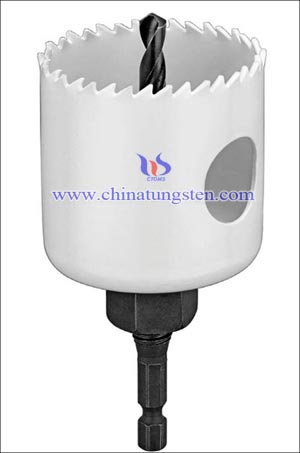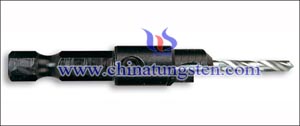Pressing Process Effect on Tungsten Copper Electrode Properties IV
- Details
- Category: Tungsten Information
- Published on Friday, 13 November 2015 17:20
- Written by xiaobin
- Hits: 284
For the effect of compaction pressure of tungsten copper electrode hardness, the pressure is suddenly increased in the beginning, the hardness of tungsten copper electrode can be increased 10-20HB. While when the pressure rises to a certain degree, the hardness is almost unchanged, despite the increasing pressure. As the result of the pressing pressure is relatively small, the powder body is pressed into blank, which decrease the porosity rapidly and improve the density of tungsten copper electrode remarkably. But the contact area among the particles is still small so that strength increase is slower.
When the pressing pressure is greater, the particles can only increase contact area and reduce the porosity by elastic plastic deformation so that the density increases smoothly. However, due to the distance of particles reduce, the contact area increase, interaction force of atoms are emerging, which the strength of the rapidly improved. When the pressing force climb to a certain degree, the density and hardness of pressed compact is maximum, it will not change no matter how the pressure changes.
More information about pressing process effect on tungsten copper electrode properties, click here:
http://news.chinatungsten.com/en/tungsten-information/80252-ti-10309
http://news.chinatungsten.com/en/tungsten-information/80294-ti-10312
http://news.chinatungsten.com/en/tungsten-information/80295-ti-10313
| Tungsten Copper Supplier: Chinatungsten Online tungsten-copper.com | Tel.: 86 592 5129696; Fax: 86 592 5129797;Email:sales@chinatungsten.com |
| Tungsten News & Prices, 3G Version: http://3g.chinatungsten.com | Molybdenum News & Molybdenum Price: http://news.molybdenum.com.cn |
Tungsten Carbide Wood Working Drill Bits Ⅵ
- Details
- Category: Tungsten Information
- Published on Friday, 13 November 2015 17:20
- Written by zhihua
- Hits: 322
In last part we know that as tungsten carbide wood working drill bits, countersink bits are used to counterbore holes, while bi-metal hole saws have a tungsten carbide edge as well as a diamond one. In this part we go on to introduce more types of wood working drill bits.
10. Plug Cutter
A plug cutter bores holes in wood, creating wood plugs for use in concealing recessed fasteners.When screw holes are drilled with carbide tipped countersink bits, the drilling creates a deeper hole enabling the screw head to be inserted below the surface. This allows a plug to be inserted into the piece and then sanded down creating a flat and clean surface.
11. Step Bit
A step bit is designed primarily for drilling in thin — up to 1/4 inch — metal, but will work with wood. The stepped design allows you to use a single bit to drill holes with different diameters. Often the diameter of each step is etched into the bit. You can also use this type of bit to deburr holes, clearing away waste material.

(The end This article is divided into several parts and this is part 6, for part 5 please refer to http://news.chinatungsten.com/en/tungsten-information/80346-ti-10356)
| Tungsten Carbide Supplier: Chinatungsten Online tungsten-carbide.com.cn | Tel.: 86 592 5129696; Fax: 86 592 5129797;Email:sales@chinatungsten.com |
| Tungsten News&Tungsten Prices, 3G Version: http://3g.chinatungsten.com | Molybdenum News & Molybdenum Price: http://news.molybdenum.com.cn |
Tungsten Carbide Wood Working Drill Bits Ⅳ
- Details
- Category: Tungsten Information
- Published on Friday, 13 November 2015 17:16
- Written by zhihua
- Hits: 323
In last part we know that as tungsten carbide wood working drill bits, a spade bit has one or two spade shaped points, while a forstner bit is used to create flat-bottomed holes.In this part we go on to introduce more types of wood working drill bits.
6. Twist Bit
A twist bit is the conventional and most common type of drill bit not only for wood working use at home, but also for many other kinds of work, such as metal machining industry. It works for general-purpose drilling in wood, plastic and light metal. Twist bits have spiral flutes to help remove the wood chips easily.
7. Hole Saw
A hole saw drills large holes — such as for installing door hardware or creating a pass-through for wiring. A hole saw creates a plug of waste material; a cut-out in the side of the saw cylinder allows you to pry it out. Typically a hole saw attaches to an arbor or mandrel which includes a shank. The arbor also holds a pilot bit for centering and steadying the cutting blade. Some smaller hole saws have a built-in shank and don't use a pilot bit.

(To be continued. This article is divided into several parts and this is part 4, for part 3 please refer to http://news.chinatungsten.com/en/tungsten-information/80341-ti-10354; for part 5 please refer to http://news.chinatungsten.com/en/tungsten-information/80346-ti-10356)
| Tungsten Carbide Supplier: Chinatungsten Online tungsten-carbide.com.cn | Tel.: 86 592 5129696; Fax: 86 592 5129797;Email:sales@chinatungsten.com |
| Tungsten News&Tungsten Prices, 3G Version: http://3g.chinatungsten.com | Molybdenum News & Molybdenum Price: http://news.molybdenum.com.cn |
Tungsten Carbide Wood Working Drill Bits Ⅴ
- Details
- Category: Tungsten Information
- Published on Friday, 13 November 2015 17:18
- Written by zhihua
- Hits: 332
In last part we know that as tungsten carbide wood working drill bits, twist bits have spiral flutes for removal of chips, and a hole saw is used for cutting larger holes with pilot bit for positioning. In this part we go on to introduce more types of wood working drill bits.
8.Bi-metal Hole Saw
A bi-metal hole saw cuts through wood and metal. A hole saw with a tungsten carbide edge works on heavier materials such as ceramic tile and masonry. A hole saw with a diamond edge also works on tile and masonry, but cuts faster than carbide models.
9. Countersink Bit
A countersink bit — also called a screw pilot bit — is a specialty bit for drilling in wood. In a single action, the bit can drill pilot, countersink and counterbore holes, allowing you to countersink a fastener and install a plug over the fastener head.

(To be continued. This article is divided into several parts and this is part 5, for part 4 please refer to http://news.chinatungsten.com/en/tungsten-information/80343-ti-10355; for part 6 please refer to http://news.chinatungsten.com/en/tungsten-information/80349-ti-10357)
| Tungsten Carbide Supplier: Chinatungsten Online tungsten-carbide.com.cn | Tel.: 86 592 5129696; Fax: 86 592 5129797;Email:sales@chinatungsten.com |
| Tungsten News&Tungsten Prices, 3G Version: http://3g.chinatungsten.com | Molybdenum News & Molybdenum Price: http://news.molybdenum.com.cn |
Tungsten Carbide Wood Working Drill Bits Ⅲ
- Details
- Category: Tungsten Information
- Published on Friday, 13 November 2015 17:15
- Written by zhihua
- Hits: 337
In last part we know that as tungsten carbide wood working drill bits, auger bits and self-feed bits all have screw points to position the bits, but auger bits have large flutes to help remove chips, while self-feed bits don’t. In this part we go on to introduce more types of wood working drill bits.
4. Spade Bit
A spade bit bores large-diameter holes — up to 1-1/2 inches in diameter — in wood. It has a flattened blade with a sharp point that helps position and steady the bit. Some spade bits have points at the two edges that help create a neater hole and exit point.
5. Forstner Bit
A forstner bit bores smooth, clean holes in wood. You can use it to create flat-bottomed holes — such as for receiving dowels. If you need to bore through the work piece, it creates a neat exit hole. A point allows you to position the bit precisely on the work piece. Pull the bit out regularly to clear away chips and dust as you work. A hand-held drill typically won't give you the force or control you need to use a forstner bit, so a drill press is a better option.

(To be continued. This article is divided into several parts and this is part 3, for part 2 please refer to http://news.chinatungsten.com/en/tungsten-information/80239-ti-10316; for part 4 please refer to http://news.chinatungsten.com/en/tungsten-information/80343-ti-10355)
| Tungsten Carbide Supplier: Chinatungsten Online tungsten-carbide.com.cn | Tel.: 86 592 5129696; Fax: 86 592 5129797;Email:sales@chinatungsten.com |
| Tungsten News&Tungsten Prices, 3G Version: http://3g.chinatungsten.com | Molybdenum News & Molybdenum Price: http://news.molybdenum.com.cn |





 sales@chinatungsten.com
sales@chinatungsten.com